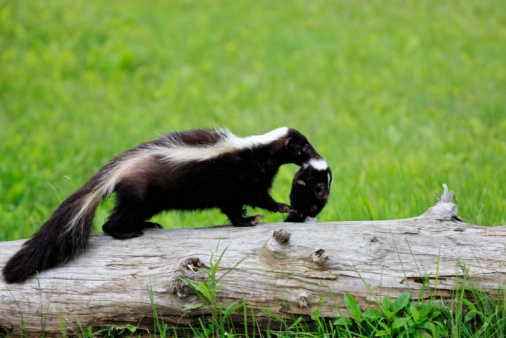Skunks usually become a problem in Toronto during the late summer months. It is when most people notice their existence in back yards, under decks and sheds. In order to properly conduct skunk control, it is imperative to understand the life cycle of the animal. Skunks usually mate from mid February to mid march. In about 2 months later, the babies are born. Breeding season starts in February and it lasts until the month of March ends. Sometimes males stay with the females; however, they often leave by April. In early may or late April, 61 to 69 days after mating, the females give birth to up to 10 mouse-sized kits; however, litters are often 5 to 6. Skunk infants are born deaf, blind, almost naked but the white and black color pattern shows.
The infants weigh approximately one ounce. At a week of age, an infant skunk doubles its weight to 2 ounces. At a fortnight, infants are usually fully furred, and they weigh approximately 41/2 ounces. After 17-21 days, their ears and eyes open, and after four weeks, the kits weigh approximately 12 ounces and they begin walking. At this moment, they are already in a position to scold if angered and stamp their feet. They may also try assuming their stance for spraying. The musk glands are often approximately the size of peas.
In July or late June, the kits are approximately seven weeks old and are nearly 11/2 pounds. At this point, they will start making excursions outside the den with the mother. When the infants are two months old, they start traveling with the mother, and they are fully weaned.
By the month of October, the young skunks may be mistaken for the adults; however, it is their small sizes that make them different. At this time, skunks often make winter dens. The young ones share dens with the mothers during the winter. In warmer seasons, skunks stay active during most of the winter period. In cold regions, skunks sleep throughout the coldest periods; however, they do not hibernate. In many occasions, skunks use the same dens they used during the previous year.
